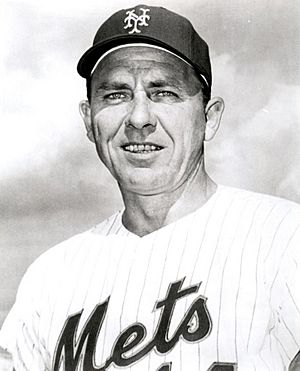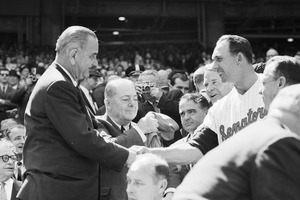Gil Hodges facts for kids
Quick facts for kids Gil Hodges |
|||
|---|---|---|---|

Hodges with the New York Mets in 1971
|
|||
| First baseman / Manager | |||
| Born: April 4, 1924 Princeton, Indiana, U.S. |
|||
| Died: April 2, 1972 (aged 47) West Palm Beach, Florida, U.S. |
|||
|
|||
| debut | |||
| October 3, 1943, for the Brooklyn Dodgers | |||
| Last appearance | |||
| May 5, 1963, for the New York Mets | |||
| MLB statistics | |||
| Batting average | .273 | ||
| Home runs | 370 | ||
| Runs batted in | 1,274 | ||
| Managerial record | 650–753 | ||
| Winning % | .463 | ||
| Teams | |||
As player
As manager
|
|||
| Career highlights and awards | |||
|
|||
| Induction | 2022 | ||
| Vote | 75% | ||
| Election Method | Golden Days Era Committee | ||
Gil Hodges was a famous American baseball player and manager. He played most of his 18-year career as a first baseman for the Brooklyn Dodgers and Los Angeles Dodgers. Many people thought he was the best first baseman in the 1950s.
Hodges was known for hitting many home runs and for being a great defensive player. He won the first three Gold Glove Awards for his excellent fielding. Later, he became a manager and led the New York Mets to a surprising 1969 World Series championship. He was honored in the Baseball Hall of Fame in 2022.
Contents
Early Life and Military Service
Gil Hodges was born in Princeton, Indiana, on April 4, 1924. His father was a coal miner. Gil grew up in Petersburg and was a talented athlete. He played four sports in high school: football, baseball, basketball, and track.
He signed with the Brooklyn Dodgers in 1943. After playing one game, he joined the United States Marine Corps during World War II. He fought in important battles like Tinian and Okinawa. He even received a medal for his bravery. After the war, he returned to baseball.
Playing for the Dodgers
Hodges rejoined the Dodgers in 1947. This was the same year that Jackie Robinson broke the color barrier in baseball. Hodges started as a catcher, but soon became the team's first baseman.
He quickly became a star. In 1949, he achieved a rare feat called hitting for the cycle. This means he hit a single, a double, a triple, and a home run in the same game. He also hit 23 home runs that year.
On August 31, 1950, Hodges made history by hitting four home runs in a single game. This is a very rare achievement in baseball. He was also excellent at defense, leading the league in double plays.
Hodges was an All-Star eight times between 1949 and 1957. He was very popular with fans in Brooklyn. Even when he had a tough time hitting in the 1952 World Series, fans supported him. A priest even asked his church members to pray for Gil Hodges!
World Series Wins
Hodges played a key role in the Dodgers' success. He helped them win the 1955 World Series, which was the team's first championship ever. In Game 7, he drove in two important runs to help the Dodgers win 2–0.
In 1958, the Dodgers moved from Brooklyn to Los Angeles. Hodges continued to play well. In 1959, he helped the Dodgers win another World Series title. They beat the Chicago White Sox in six games.
Hodges was also recognized for his great defense. He won the first three Gold Glove Awards given to first basemen, from 1957 to 1959. He was a truly complete player.
Return to New York as a Player
In 1962, Gil Hodges was chosen by the new New York Mets team. He became one of the original Mets players. He even hit the first home run in the team's history! He played for the Mets for two seasons.
By the end of his playing career, Hodges had hit 370 home runs. This was one of the highest totals for a right-handed batter at that time.
Becoming a Manager
After playing 11 games for the Mets in 1963, Hodges retired as a player. He was traded to the Washington Senators to become their manager. He managed the Senators for five seasons, and the team improved each year.
In 1968, Hodges returned to New York to manage the New York Mets. The Mets had been a struggling team for many years. Hodges was known for being a calm and smart leader. He taught his players the importance of hard work and teamwork.
The "Miracle Mets"
In 1969, Hodges led the Mets to an amazing season. They were called the "Miracle Mets" because they were not expected to win. Hodges used a strategy called "platooning," where he used different players depending on who they were playing against. This kept everyone fresh and involved.
The Mets made it to the 1969 World Series and faced the strong Baltimore Orioles. The Mets won the series in five games, which was one of the biggest upsets in sports history! Hodges was named The Sporting News Manager of the Year for this incredible achievement. He continued to manage the Mets through the 1971 season.
Legacy and Honors
Gil Hodges passed away suddenly on April 2, 1972, just before the start of the new baseball season. He was only 47 years old. His death was a shock to the baseball world. Many players and fans remembered him as a great player and an even better person.
The Mets honored Hodges by retiring his uniform number 14 in 1973. This means no other Mets player will ever wear that number. In 2022, the Los Angeles Dodgers also retired his number 14.
 |
|
| Gil Hodges's number 14 was retired by the Los Angeles Dodgers in 2022. |
 |
|
| Gil Hodges's number 14 was retired by the New York Mets in 1973. |
Hodges was inducted into the New York Mets Hall of Fame in 1982. Many places in New York and Indiana are named after him. For example, the Marine Parkway–Gil Hodges Memorial Bridge in New York City is named in his honor.
For many years, fans and experts believed Gil Hodges deserved to be in the Baseball Hall of Fame. Finally, in December 2021, he was elected to the Hall of Fame by the Golden Days Era Committee. He was officially inducted in July 2022, recognizing his incredible career as both a player and a manager.
Images for kids
-
The Marine Parkway–Gil Hodges Memorial Bridge at night, circa 2014








